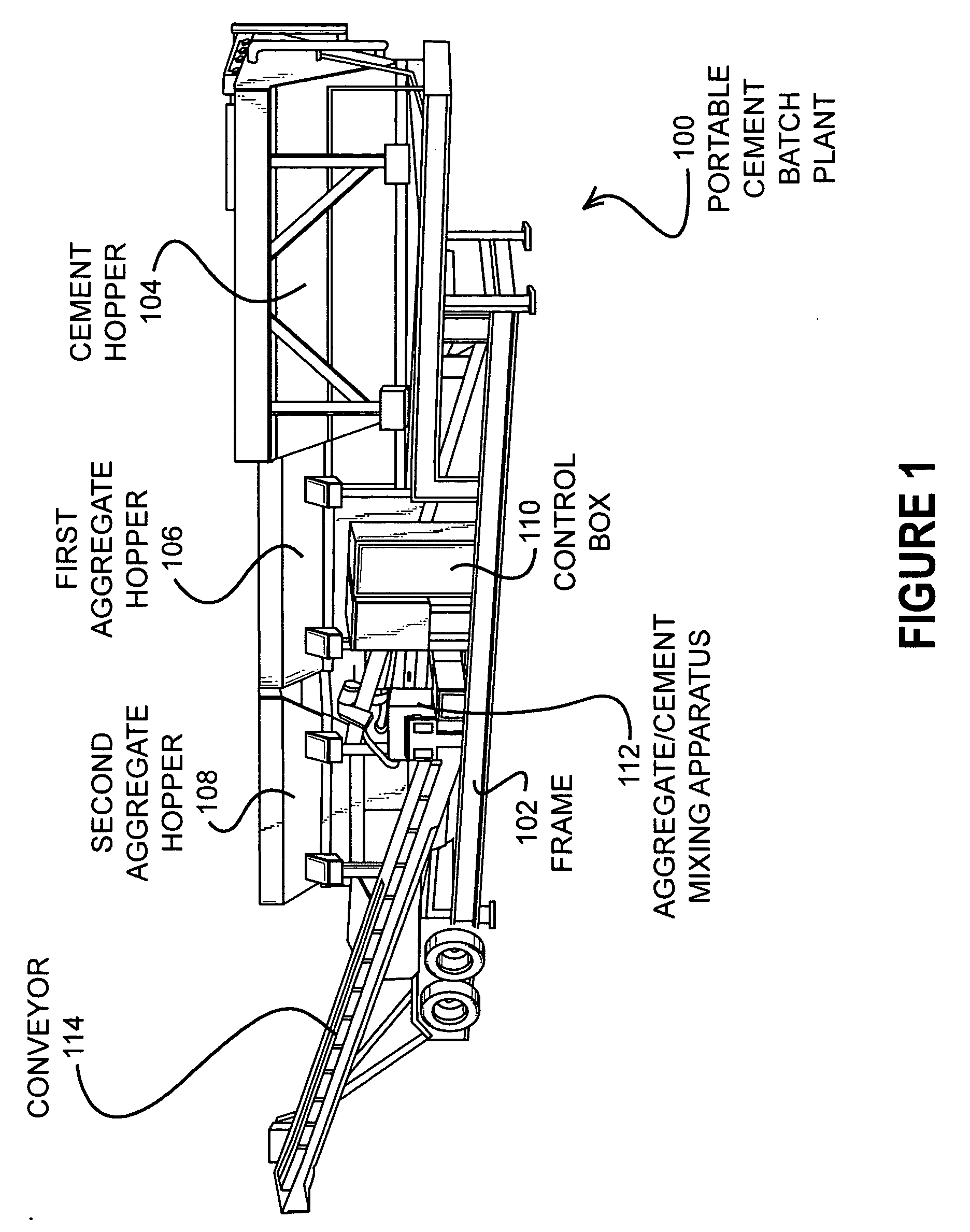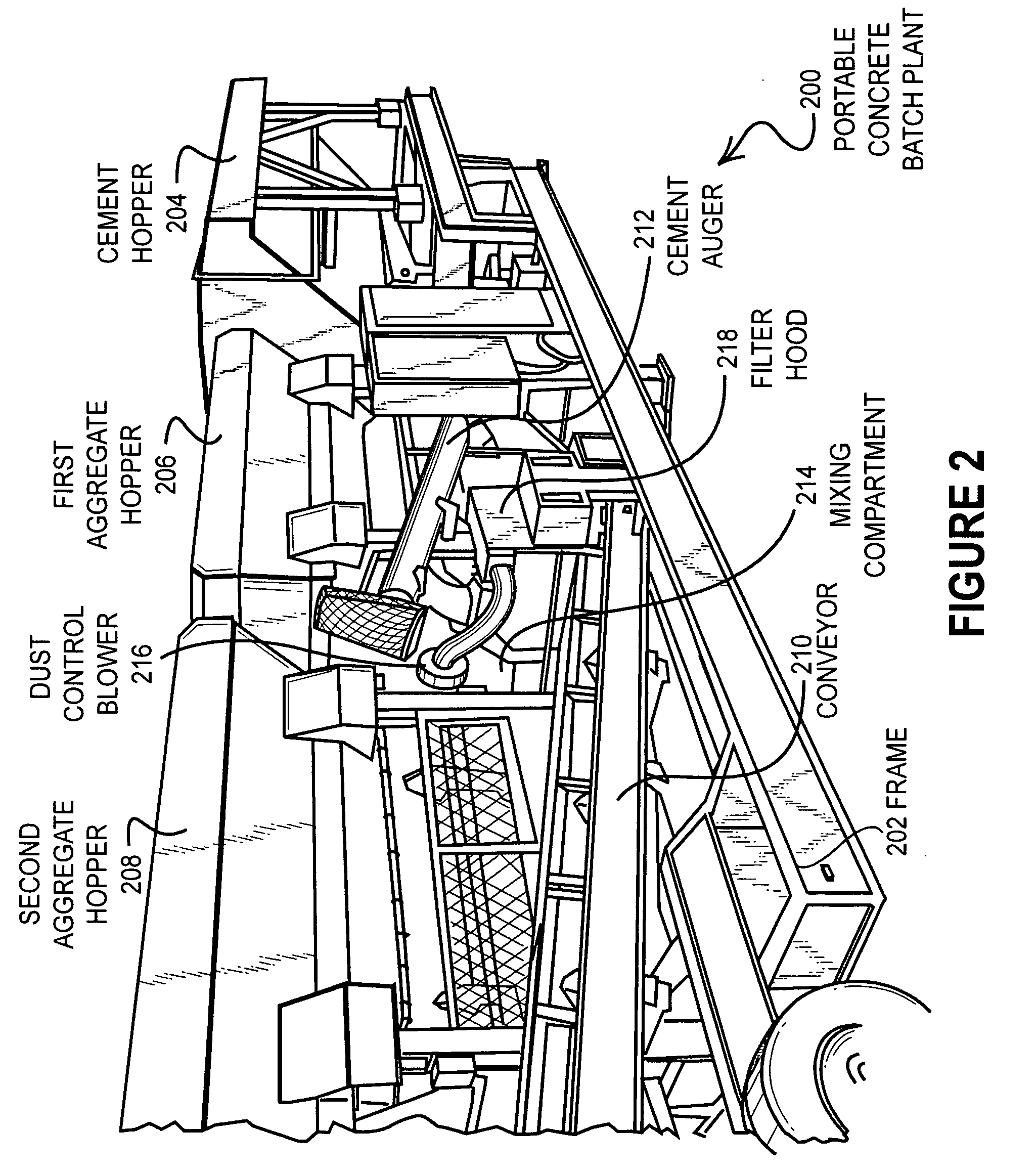Chemical dispensing system for a portable concrete plant
a concrete plant and chemical technology, applied in adaptive control, computer control, instruments, etc., can solve the problems of inability to accurately dispense concrete, inability to accurately measure the level of fill at the sight gauge, and the tendency to overlook the injection of chemical substances, etc., to achieve the effect of increasing repeatability and dispense more accurately
- Summary
- Abstract
- Description
- Claims
- Application Information
AI Technical Summary
Benefits of technology
Problems solved by technology
Method used
Image
Examples
embodiment 100
[0019]FIG. 1 illustrates an embodiment 100 of the present invention of a portable cement batch plant that has an automated chemical dispensing system. The frame 102 has several hoppers mounted thereupon: a cement hopper 104, a first aggregate hopper 106, and a second aggregate hopper 108. The control box 110 contains a computerized control system that directs the dispensing of the various dry materials, such as cement, sand, and rock, into a dry mixing apparatus 112 and a conveyor 114. The conveyor 114 may deliver the pre-mixed dry components into a portable concrete mixer truck.
[0020] The plant 100 is designed to charge a concrete mixing truck with a batch of raw materials per a certain specification based on a mix design. The specification may include a certain amount of dry ingredients, such as cement, rock, and sand, as well as certain amounts of water and various chemical agents typically added to concrete mixes. These agents may include water reducing agents, stabilizers, reta...
embodiment 200
[0026]FIG. 2 illustrates a close up view of an embodiment 200 of a cement batch plant. The frame 202 holds the cement hopper 204, the first aggregate hopper 206, and the second aggregate hopper 208. The delivery conveyor 210 takes the mixed aggregate and cement from the mixing apparatus 214. A cement auger 212 transfers the dry cement from the cement hopper 204 into the mixing apparatus 214. A filtered dust hood 218 is mounted near the exit of the cement auger 212 and has a dust control blower 216 for pulling any excess dust into the filter membrane contained inside the dust hood 218.
[0027]FIG. 3 illustrates a schematic representation of a control system 300 for a typical batch plant. A controller 302 controls a cement hopper 304 and an aggregate hopper 306 to dispense cement 305 and aggregate 307, respectively, into a dry mixing apparatus 308, which dispenses a mixed cement and aggregate 309 into a mixing truck 312. The controller 302 also controls a water / chemical dispensing appar...
embodiment 400
[0033]FIG. 4 illustrates a schematic representation of an embodiment 400 of a water and chemical dispensing apparatus. A controller 402 may control water pump 404 to pump water from a water source 406, through a flow meter 408, and into a mixing drum 424 as might be mounted on a portable mixing truck. Additionally, the controller 402 directs a chemical pump 414 to pump chemicals from a chemical source 416 through a flow meter 418 and into the mixing drum 424. A pair of valves 426 and 428 may be operated to direct the chemical output into a calibrated measurement container 430.
[0034] For both the water circuit and the chemical circuit, the liquid materials are mechanically pumped and the output is monitored by a flow meter. The flow meter serves to measure the proper amount of water or chemical that is dispensed.
[0035] The pumps used in the apparatus 400 may be positive or variable displacement pumps. Sending a stream of pulses to the controller 402 may cause such pumps to pump a ce...
PUM
| Property | Measurement | Unit |
|---|---|---|
| diameter | aaaaa | aaaaa |
| chemical | aaaaa | aaaaa |
| chemical measuring | aaaaa | aaaaa |
Abstract
Description
Claims
Application Information
 Login to View More
Login to View More - R&D
- Intellectual Property
- Life Sciences
- Materials
- Tech Scout
- Unparalleled Data Quality
- Higher Quality Content
- 60% Fewer Hallucinations
Browse by: Latest US Patents, China's latest patents, Technical Efficacy Thesaurus, Application Domain, Technology Topic, Popular Technical Reports.
© 2025 PatSnap. All rights reserved.Legal|Privacy policy|Modern Slavery Act Transparency Statement|Sitemap|About US| Contact US: help@patsnap.com



